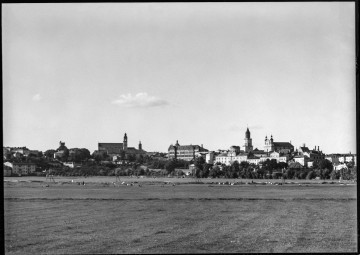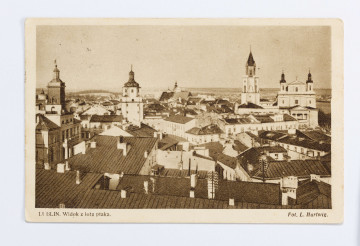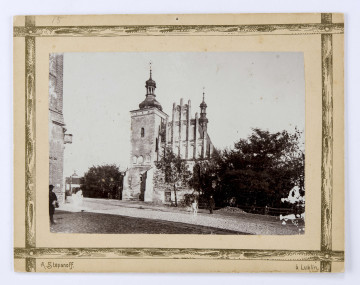
Panorama of Lublin from Rusałka Street
1931
National Museum in Lublin
Part of the collection: Photographs of Lublin
At the end of the 16th century, the Jesuits settled in Lublin. They were brought there in 1582 by Bernard Maciejowski, later the Primate of Poland. The monks were given a tenement house in the town. In time, they acquired a considerable area on both sides of the city wall. After obtaining permission from the city authorities, confirmed by King Stefan Batory, they pulled down the wall. The place was then occupied by school buildings, a college and a church, which is today's arch-cathedral.
The church, dedicated to St John the Baptist and John the Evangelist, was designed by Giovanni Maria Bernardoni. The model for the Lublin church was Il Gesù in Rome. The College contained school and theatre rooms, living quarters, a library and chapels. Next to it there were farm buildings and a pharmacy. The whole formed a closed quadrangle. Inside, the space was planted with trees. The estate was plumbed in the 17th century. The Jesuits supplied water through underground channels, using the town's water supply.
The interior of the church, renovated after a fire in 1752, was covered with frescoes by Josef Meyer. The artist used illusionist painting to create the illusion of a larger space.
After the dissolution of the Jesuit Order in 1773, their property passed to the National Education Commission, and then to the Trinitarians. The latter could not cope with maintaining such a large complex. After the Lublin diocese was established in 1805, the post-Jesuit church was used as the bishop's seat. In 1815, the demolition of the college wings began. The remaining buildings were given to the Russian government grammar school. In place of the former monastery gate from the side of the city, the neo-Gothic Trinity Tower, designed by Antoni Corazzi, was erected. The rubble of the buildings was used for the embankment at Żmigród Street and the junction of Zamojska and Bernardyńska Streets.
Destroyed during World War II, the cathedral was rebuilt. After 1990, a section of Zamojska Street was renamed after Kardynała Stefana Wyszyńskiego. The buildings of the former Jesuit college currently house the State Archive.
Author / creator
Dimensions
cały obiekt: height: 19 cm, width: 14,8 cm
Object type
photography
Technique
sepia
Material
paper, cardboard, ink
Creation time / dating
Creation / finding place
Owner
The National Museum in Lublin
Identification number
Location / status

1931
National Museum in Lublin

1935
National Museum in Lublin

1880 — 1900
National Museum in Lublin
DISCOVER this TOPIC
Museum of King Jan III's Palace at Wilanów
DISCOVER this PATH
Educational path